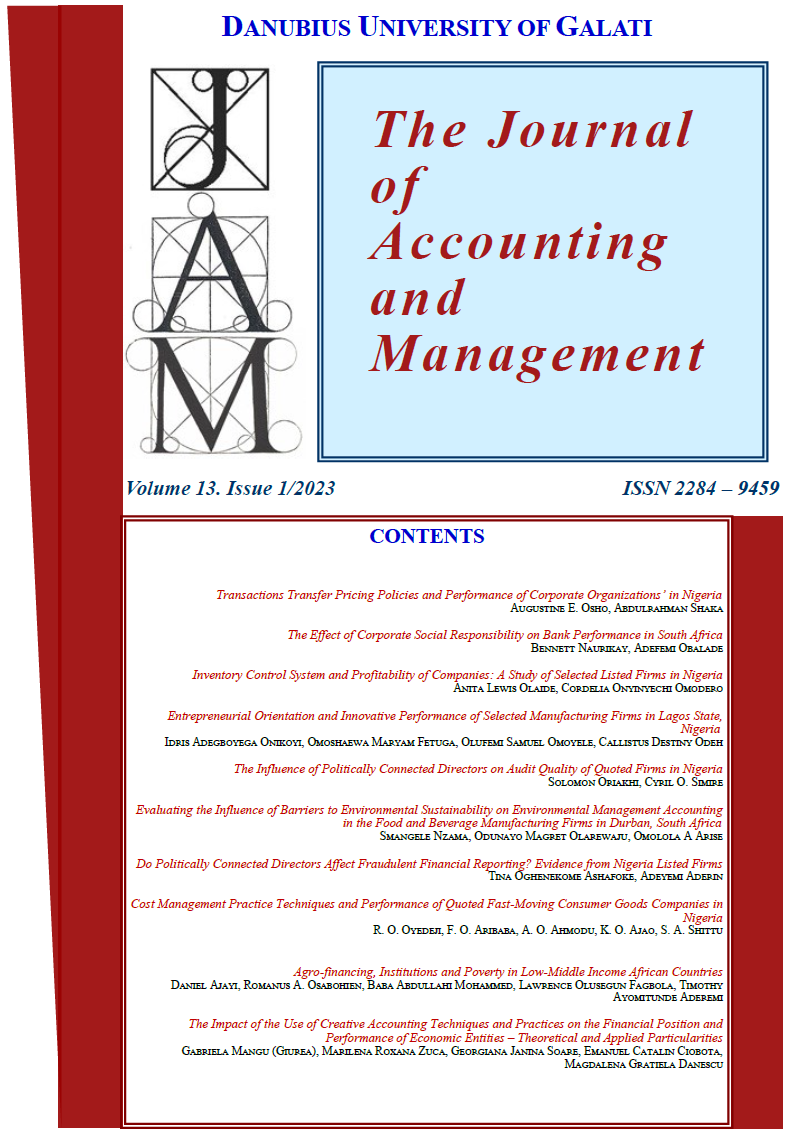The Impact of the Use of Creative Accounting Techniques and Practices on the Financial Position and Performance of Economic Entities – Theoretical and Applied Particularities
Keywords:
creative accounting; techniques and practices of creative accounting; financial position; financial performance; economic entityAbstract
The theoretical approach of creative accounting techniques and practices captures the way in which the accounting information that characterizes the financial position and performance of the economic entity is influenced. The presentation of the numerous typologies of techniques and practices specific to creative accounting is necessary for all categories of users of financial-accounting information because in this way their effects on the annual financial statements are (re)known and economic decisions are made in the knowledge of the case.
References
Beneish M. D., Nichols C., (2005), Earnings Quality and Future Returns: The relation Between Accruals and the Probability of Earnings Manipulation, working paper, SSRN.
Beneish M.D., (1999), The Detection of Earnings Manipulation, Financial Analysts Journal 55, No. 5, pp. 24-36.
Bonnet F., (1995), Pièges (et délices) de la comptabilité (créative), Economica, Paris.
Clatworthy M., Jones M., (2001), “The effect of thematic structure on the variability of the annual report readability, Accounting, Auditing and Accountability Journal, Volume 14, Number 3, pp. 311-326
Colasse B., (1997), General accounting, 4th Edition, translation by lecturer Neculai Tabără, Moldova Publishing House.
Dechow P.M., Ge W., & Schrand C.M., (2010), Understanding Earnings Quality: A Review of the Proxies, Their Determinants and Their Consequences, Journal of Accounting and Economics, 50 (2-3), 344-401. http://dx.doi.org/10.1016/j.jacceco.2010.09.001
Degos J.G., (2002), Comptabilité créative et gouvernance: dualité de l'image flatteuse et de l'image fidèle, La Revue du FINANCIER, Nr. 133, pp. 54-68.
Diaconu P., (2004), How do accountants make money? Tax evasion, tax havens, creative accounting, Economica Publishing House, Bucharest.
Dumitrescu A.S., (2014),”Creative Accounting, from idea to money, with practical examples”, Economica Publishing House, Bucharest, pp. 13.
Feleagă N., (1996), Accounting controversies, conceptual difficulties and the credibility of accounting, Economica Publishing House, Bucharest.
Feleagă N., Malciu L., (2002), Accounting policies and options (Fair accounting versus Bad accounting), Economica Publishing House, Bucharest.
Groșanu A., (2013), Creative accounting, Collection Postdoctoral Advanced Research in Economic Sciences, ASE Publishing House, Bucharest, pp. 38.
Jones M., (1996), Readability of annual reports: Western versus Asian evidence – a comment on contextualize, Accounting, Auditing and Accountability Journal, Volume 9, Number 2, pp. 86
Lang M., Lundholm R., (2000), Voluntary Disclosure and Equity Offerings: Reducing Information Asymmetry or Hyping the Stock?, Contemporary Accounting Research, Volume 17, Number 4, pp. 623-662.
Malciu L., (1999), Creative accounting, Economica Publishing House, Bucharest.
McEnroe J.E., (2007), Individual Investorsʼ Perceptions Involving the Quality and Usefulness of Audited Financial Statements, Advances in Public Interest Accounting, Vol. 13, pp. 63-79.
Mulford C., Comiskey E., (2002),”The Financial Numbers Game. Detecting Creative Accounting Practices”, John Wiley & Sons, Inc, pp. 9.
Munteanu V., Zuca M., (2011), Considerations regarding the use of creative accounting in distorting information from financial statements and "maximizing" the company's performance, Financial Audit Journal, Year IX, No. 3, pp. 3-10.
Naser K., (1993), Creative accounting – its nature and use, Editura Pretince Hall International, London.
Robu I. B., Robu M. A., (2013), Audit procedures for estimating the fraud risk based on indexes for detection of accounting manipulation” Financial Audit Review, No. 10, pp. 3-16.
Rybaud-Turillo B., Teller R., (1997), Comptabilité créative, Encyclopédie de Gestion, Economica, Paris, pp. 508-527.
Stanton P., Stanton J., Pires G., (2004), Impression of an annual report: an experimental study, Corporate Communications: An International Journal, Volume 9, Number 1.
Stolowy H., (2000), Comptabilité créative, Encyclopédie de Comptabilité, Contrôle de Gestion et Audit (under the guidance of Colasse B.), Economica, Paris, pp. 157-178.
Stolowy H., (1999), Comptabilité creative, Encyclopédie de Comptabilité, Contrôle de gestion et Audit, Economica, pp. 157-178.
Vladu A.B., Groșanu A., Cuzdriorean D.D., (2012), When creative accounting has a different path: positive bias and persuasive language – an experimental study, Journal of International Management Studies, 12(2), pp. 105-111.
Wills D., (2008), Perceptions of Company Performance: A study of Impression Management, Working paper, University of Tasmania.
Yin R.K., (1994),”Case study research: Design and methods”, 2nd Edition, Thousand Oaks, CA: Sage.
Downloads
Published
How to Cite
Issue
Section
License
Copyright (c) 2023 Marilena Roxana Zuca, Janina Soare, Emanuel – Catalin Ciobota, Magdalena - Gratiela Danescu

This work is licensed under a Creative Commons Attribution-NonCommercial 4.0 International License.
The author fully assumes the content originality and the holograph signature makes him responsible in case of trial.

